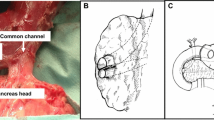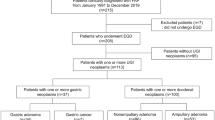Abstract
Purpose
Pancreaticoduodenectomy is an alternative to pancreas-sparing duodenectomy for radical treatment of duodenal lesions. The aims of this study were to assess the results of pylorus-preserving pancreaticoduodenectomy (PPPD) for severe duodenal polyposis in familial adenomatous polyposis in terms of morbidity, long-term influence on functional results, the recurrence rate of cancer or jejunal polyps, and survival.
Methods
All patients operated on for a PPPD between 1992 and 2009 were included. Clinical data, endoscopic findings, and pathologic examinations were evaluated.
Results
A total of 19 patients underwent PPPD for severe duodenal polyposis (17 Spigelman IV, 1 Spigelman III, and 1 invasive carcinoma). Postoperative mortality was nil. The postoperative morbidity rate was 42%, including 4 pancreatic fistulae (21%) and 2 delayed gastric emptying (11%). Pathologic examination found 7 invasive carcinomas, of which only 1 was known before resection. One third of patients operated on without a preoperative diagnosis of malignancy already had an invasive duodenal carcinoma. After a mean follow-up of 58 months, 16 patients were alive. Thirteen patients underwent endoscopic follow-up, and new adenomas were found in 4 (31%). All were treated successfully during the same endoscopic procedure. PPPD did not modify the functional result after coloproctectomy.
Conclusions
PPPD remains a safe and efficient therapeutic option for severe duodenal polyposis in familial adenomatous polyposis patients.

Similar content being viewed by others
References
Spigelman AD, Talbot IC, Penna C, Nugent KP, Phillips RK, Costello C, et al. Evidence for adenoma-carcinoma sequence in the duodenum of patients with familial adenomatous polyposis. The Leeds Castle Polyposis Group (Upper Gastrointestinal Committee). J Clin Pathol. 1994;47:709–10.
Offerhaus GJ, Giardiello FM, Krush AJ, Booker SV, Tersmette AC, Kelley NC, et al. The risk of upper gastrointestinal cancer in familial adenomatous polyposis. Gastroenterology. 1992;102:1980–2.
Nugent KP, Spigelman AD, Phillips RK. Life expectancy after colectomy and ileorectal anastomosis for familial adenomatous polyposis. Dis Colon Rectum. 1993;36:1059–62.
Sarre RG, Frost AG, Jagelman DG, Petras RE, Sivak MV, McGannon E. Gastric and duodenal polyps in familial adenomatous polyposis: a prospective study of the nature and prevalence of upper gastrointestinal polyps. Gut. 1987;28:306–14.
Spigelman AD, Williams CB, Talbot IC, Domizio P, Phillips RK. Upper gastrointestinal cancer in patients with familial adenomatous polyposis. Lancet. 1989;2:783–5.
Domizio P, Talbot IC, Spigelman AD, Williams CB, Phillips RK. Upper gastrointestinal pathology in familial adenomatous polyposis: results from a prospective study of 102 patients. J Clin Pathol. 1990;43:738–43.
Church JM, McGannon E, Hull-Boiner S, Sivak MV, Van Stolk R, Jagelman DG, et al. Gastroduodenal polyps in patients with familial adenomatous polyposis. Dis Colon Rectum. 1992;35:1170–3.
Jagelman DG, DeCosse JJ, Bussey HJ. Upper gastrointestinal cancer in familial adenomatous polyposis. Lancet. 1988;1:1149–51.
Groves CJ, Saunders BP, Spigelman AD, Phillips RK. Duodenal cancer in patients with familial adenomatous polyposis (FAP): results of a 10 year prospective study. Gut. 2002;50:636–41.
Spigelman AD, Granowska M, Phillips RK. Duodeno-gastric reflux and gastric adenomas: a scintigraphic study in patients with familial adenomatous polyposis. J R Soc Med. 1991;84:476–8.
Spigelman AD, Scates DK, Venitt S, Phillips RK. DNA adducts, detected by 32P-postlabelling, in the foregut of patients with familial adenomatous polyposis and in unaffected controls. Carcinogenesis. 1991;12:1727–32.
Parc Y, Mabrut JY, Shields C. Surgical management of the duodenal manifestations of familial adenomatous polyposis. Br J Surg. 2011;98:480–4.
Fawal H, Gambiez L, Raad A, Pruvot FR, Chambon JP, Saudemont A, et al. Management of duodenal adenomatosis in patients with familial adenomatous polyposis. Ann Chir. 2003;128:594–8.
Bleau BL, Gostout CJ. Endoscopic treatment of ampullary adenomas in familial adenomatous polyposis. J Clin Gastroenterol. 1996;22:237–41.
Penna C, Bataille N, Balladur P, Tiret E, Parc R. Surgical treatment of severe duodenal polyposis in familial adenomatous polyposis. Br J Surg. 1998;85:665–8.
Ouaissi M, Panis Y, Sielezneff I, Alves A, Pirro N, Robitail S, et al. Long-term outcome after ampullectomy for ampullary lesions associated with familial adenomatous polyposis. Dis Colon Rectum. 2005;48:2192–6.
Gallagher MC, Shankar A, Groves CJ, Russell RC, Phillips RK. Pylorus-preserving pancreaticoduodenectomy for advanced duodenal disease in familial adenomatous polyposis. Br J Surg. 2004;91:1157–64.
de Cappel WH, Jarvinen HJ, Bjork J, Berk T, Griffioen G, Vasen HF. Worldwide survey among polyposis registries of surgical management of severe duodenal adenomatosis in familial adenomatous polyposis. Br J Surg. 2003;90:705–10.
Greenblatt WH, Hur C, Knudsen AB, Evans JA, Chung DC, Gazelle GS. Cost-effectiveness of prophylactic surgery for duodenal cancer in familial adenomatous polyposis. Cancer Epidemiol Biomarkers Prev. 2009;18:2677–84.
Skipworth JR, Morkane C, Raptis DA, Vyas S, Olde Damink SW, Imber CJ, et al. Pancreaticoduodenectomy for advanced duodenal and ampullary adenomatosis in familial adenomatous polyposis. HPB (Oxford). 2011;13:342–9.
Al-Sarireh B, Ghaneh P, Gardner-Thorpe J, Raraty M, Hartley M, Sutton R, et al. Complications and follow-up after pancreas-preserving total duodenectomy for duodenal polyps. Br J Surg. 2008;95:1506–11.
Alarcon FJ, Burke CA, Church JM, van Stolk RU. Familial adenomatous polyposis: efficacy of endoscopic and surgical treatment for advanced duodenal adenomas. Dis Colon Rectum. 1999;42:1533–6.
Chung RS, Church JM, vanStolk R. Pancreas-sparing duodenectomy: indications, surgical technique, and results. Surgery. 1995;117:254–9.
de Castro SM, van Eijck CH, Rutten JP, Dejong CH, van Goor H, Busch OR, et al. Pancreas-preserving total duodenectomy versus standard pancreatoduodenectomy for patients with familial adenomatous polyposis and polyps in the duodenum. Br J Surg. 2008;95:1380–6.
Kalady MF, Clary BM, Tyler DS, Pappas TN. Pancreas-preserving duodenectomy in the management of duodenal familial adenomatous polyposis. J Gastrointest Surg. 2002;6:82–7.
Mackey R, Walsh RM, Chung R, Brown N, Smith A, Church J, et al. Pancreas-sparing duodenectomy is effective management for familial adenomatous polyposis. J Gastrointest Surg. 2005;9:1088–93; discussion 93.
Sarmiento JM, Thompson GB, Nagorney DM, Donohue JH, Farnell MB. Pancreas-sparing duodenectomy for duodenal polyposis. Arch Surg. 2002;137:557–62; discussion 62–3.
Vallance S. Duodenectomy without pancreatectomy for extensive benign villous adenoma of the duodenum. Aust N Z J Surg. 1990;60:311–4.
Tsiotos GG, Sarr MG. Pancreas-preserving total duodenectomy. Dig Surg. 1998;15:398–403.
Johnson MD, Mackey R, Brown N, Church J, Burke C, Walsh RM. Outcome based on management for duodenal adenomas: sporadic versus familial disease. J Gastrointest Surg. 2010;14:229–35.
Parc YR, Olschwang S, Desaint B, Schmitt G, Parc RG, Tiret E. Familial adenomatous polyposis: prevalence of adenomas in the ileal pouch after restorative proctocolectomy. Ann Surg. 2001;233:360–4.
Saurin JC, Napoleon B, Gay G, Ponchon T, Arpurt JP, Boustiere C, et al. Endoscopic management of patients with familial adenomatous polyposis (FAP) following a colectomy. Endoscopy. 2005;37:499–501.
Dunlop MG. Guidance on gastrointestinal surveillance for hereditary non-polyposis colorectal cancer, familial adenomatous polyposis, juvenile polyposis, and Peutz-Jeghers syndrome. Gut. 2002;51(Suppl. 5):V21–7.
Miossec S, Parc R, Paye F. Ampullectomy in benign lesion: indications and results. Ann Chir. 2004;129:73–8.
Imanaga H. A new method of pancreaticoduodenectomy designed to preserve liver and pancreatic function. Surgery. 1960;47:577–86.
Hishinuma S, Ogata Y, Matsui J, Ozawa I. Evaluation of pylorus-preserving pancreatoduodenectomy with the Imanaga reconstruction by hepatobiliary and gastrointestinal dual scintigraphy. Br J Surg. 1999;86:1306–11.
Morpurgo E, Vitale GC, Galandiuk S, Kimberling J, Ziegler C, Polk HC Jr. Clinical characteristics of familial adenomatous polyposis and management of duodenal adenomas. J Gastrointest Surg. 2004;8:559–64.
Dindo D, Demartines N, Clavien PA. Classification of surgical complications: a new proposal with evaluation in a cohort of 6336 patients and results of a survey. Ann Surg. 2004;240:205–13.
Bassi C, Dervenis C, Butturini G, Fingerhut A, Yeo C, Izbicki J, et al. Postoperative pancreatic fistula: an International Study Group (ISGPF) definition. Surgery. 2005;138:8–13.
Ruo L, Coit DG, Brennan MF, Guillem JG. Long-term follow-up of patients with familial adenomatous polyposis undergoing pancreaticoduodenal surgery. J Gastrointest Surg. 2002;6:671–5.
Diener MK, Knaebel HP, Heukaufer C, Antes G, Buchler MW, Seiler CM. A systematic review and meta-analysis of pylorus-preserving versus classical pancreaticoduodenectomy for surgical treatment of periampullary and pancreatic carcinoma. Ann Surg. 2007;245:187–200.
Seiler CA, Wagner M, Bachmann T, Redaelli CA, Schmied B, Uhl W, et al. Randomized clinical trial of pylorus-preserving duodenopancreatectomy versus classical Whipple resection—long term results. Br J Surg. 2005;92:547–56.
Tran KT, Smeenk HG, van Eijck CH, Kazemier G, Hop WC, Greve JW, et al. Pylorus preserving pancreaticoduodenectomy versus standard Whipple procedure: a prospective, randomized, multicenter analysis of 170 patients with pancreatic and periampullary tumors. Ann Surg. 2004;240:738–45.
Buchler MW, Friess H, Wagner M, Kulli C, Wagener V, Z’Graggen K. Pancreatic fistula after pancreatic head resection. Br J Surg. 2000;87:883–9.
Schmidt CM, Powell ES, Yiannoutsos CT, Howard TJ, Wiebke EA, Wiesenauer CA, et al. Pancreaticoduodenectomy: a 20-year experience in 516 patients. Arch Surg. 2004;139:718–25;discussion 25–7.
Yeo CJ, Cameron JL, Sohn TA, Lillemoe KD, Pitt HA, Talamini MA, et al. Six hundred fifty consecutive pancreaticoduodenectomies in the 1990s: pathology, complications, and outcomes. Ann Surg. 1997;226:248–57; discussion 57–60.
Fathy O, Wahab MA, Elghwalby N, Sultan A, El-Ebidy G, Hak NG, et al. 216 cases of pancreaticoduodenectomy: risk factors for postoperative complications. Hepatogastroenterology. 2008;55:1093–8.
Yang YM, Tian XD, Zhuang Y, Wang WM, Wan YL, Huang YT. Risk factors of pancreatic leakage after pancreaticoduodenectomy. World J Gastroenterol. 2005;11:2456–61.
Cahen DL, Fockens P, de Wit LT, Offerhaus GJ, Obertop H, Gouma DJ. Local resection or pancreaticoduodenectomy for villous adenoma of the ampulla of Vater diagnosed before operation. Br J Surg. 1997;84:948–51.
Latchford AR, Neale KF, Spigelman AD, Phillips RK, Clark SK. Features of duodenal cancer in patients with familial adenomatous polyposis. Clin Gastroenterol Hepatol. 2009;7:659–63.
Author information
Authors and Affiliations
Corresponding author
Rights and permissions
About this article
Cite this article
Caillié, F., Paye, F., Desaint, B. et al. Severe Duodenal Involvement in Familial Adenomatous Polyposis Treated by Pylorus-Preserving Pancreaticoduodenectomy. Ann Surg Oncol 19, 2924–2931 (2012). https://doi.org/10.1245/s10434-012-2221-x
Received:
Published:
Issue Date:
DOI: https://doi.org/10.1245/s10434-012-2221-x




